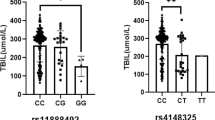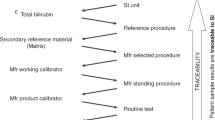Abstract
Background
To investigate the relationship between unexplained indirect hyperbilirubinemia of Vietnamese newborns and the polymorphism of the promoter TATA box and exon 1 of bilirubin uridine diphosphate glucuronosyltransferase (UGT1A1) gene.
Methods
A total of 149 neonates were divided into the hyperbilirubinemia group (n = 99) and control group (n = 50). The gene polymorphisms of UGT1A1 gene in the two groups were detected by PCR and direct sequencing, which revealed the relationship between UGT1A1 polymorphism with neonatal hyperbilirubinemia of neonates. The types of UGT1A1 polymorphism in the hyperbilirubinemia group and the peak total serum bilirubin (PSB) levels with different genotypes were observed.
Results
(1) (TA)7 insertion mutation, 211G>A, 189C>T, 190G>A, 378C>T and 686C>A were detected. (2) The allele frequency of 211G>A allele mutation was significantly different between the two groups (p < 0.05). (3) Logistic regression analysis showed that homozygosity and heterozygosity of 211G>A were both significantly associated with neonatal hyperbilirubinemia. (4) In the hyperbilirubinemia group, the peak total serum bilirubin level of 211G>A homozygous neonates was higher than that of the wild-type neonates (p < 0.05).
Conclusions
We noted that there was an association between neonates with unexplained indirect hyperbilirubinemia in Vietnam and the polymorphism of UGT1A1c.211G>A. In addition, the homozygous 211G>A polymorphism was related to the degree of hyperbilirubinemia.
Impact
-
Our article provided data on UGT1A1 polymorphism distribution in the Vietnamese population, which have not been reported yet.
-
Our findings revealed that mutations in UGT1A1 gene are risk factors for unexplained hyperbilirubinemia in Vietnamese neonates.
-
Our article will strengthen the cognition of neonatal jaundice at the genetic level in the pediatric field in Vietnam.
Similar content being viewed by others
Log in or create a free account to read this content
Gain free access to this article, as well as selected content from this journal and more on nature.com
or
References
Shin, H. J. et al. Functional study of haplotypes in UGT1A1 promoter to find a novel genetic variant leading to reduced gene expression. Ther. Drug Monit. 37, 369–374 (2015).
Liu, W. et al. Genetic factors affecting gene transcription and catalytic activity of UDP-glucuronosyltransferases in human liver. Hum. Mol. Genet. 23, 5558–5569 (2014).
Kaplan, M., Hammerman, C. & Maisels, M. J. Bilirubin genetics for the nongeneticist: hereditary defects of neonatal bilirubin conjugation. Pediatrics 111, 886–893 (2003).
Strassburg, C. P. Pharmacogenetics of Gilbert’s syndrome. Pharmacogenomics 9, 703–715 (2008).
Liu, J. Y., Qu, K., Sferruzza, A. D. & Bender, R. A. Distribution of the UGT1A1*28 polymorphism in Caucasian and Asian populations in the US: a genomic analysis of 138 healthy individuals. Anticancer Drugs 18, 693–696 (2007).
Mehrad-Majd, H. et al. Effects of Gly71Arg mutation in UGT1A1 gene on neonatal hyperbilirubinemia: a systematic review and meta-analysis. J. Matern. Fetal Neonatal Med. 32, 1575–1585 (2019).
Akaba, K. et al. Neonatal hyperbilirubinemia and mutation of the bilirubin uridine diphosphate-glucuronosyltransferase gene: a common missense mutation among Japanese, Koreans and Chinese. Biochem. Mol. Biol. Int. 46, 21–26 (1998).
Khu, D. T, Le, L. T. & Partridge, J. C. Characteristics of newborns admitted for hyperbilirubinemia at a tertiary referral hospital in Northern Vietnam. In 2009 Pediatric Academic Societies Annual Meeting [Abstract] E-PAS2009:4600.7 (Pediatric Academic Societies, Baltimore, MD, 2009).
American Academy of Pediatrics Subcommittee on Hyperbilirubinemia. Management of hyperbilirubinemia in the newborn infant 35 or more weeks of gestation. Pediatrics 114, 297–316 (2004).
Hall, D., Ybazeta, G., Destro-Bisol, G., Petzl-Erler, M. L. & Di Rienzo, A. Variability at the uridine diphosphate glucuronosyltransferase 1A1 promoter in human populations and primates. Pharmacogenetics 9, 591–599 (1999).
Yu, Z., Zhu, K., Wang, L., Liu, Y. & Sun, J. Association of neonatal hyperbilirubinemia with UGT1A1 gene polymorphisms: a meta-analysis. Med. Sci. Monit. 21, 3104–3114 (2015).
Gao, Z. Y., Zhong, D. N., Liu, Y., Liu, Y. N. & Wei, L. M. [Roles of UGT 1A1 gene mutation in the development of neonatal hyperbilirubinemia in Guangxi]. Zhonghua Er Ke Za Zhi 48, 646–649 (2010).
Hong, C., Danni, Z., Zongyan, G., Xiaojing, W. & Luming, W. Relationship between bilirubin uridine diphosphate-glucuronosyl transferase 1A1 gene mutation and susceptibility to neonatal jaudice. Shandong Med. J. 57, 22–25 (2017).
Wu, X. J., Zhong, D. N., Xie, X. Z., Ye, D. Z. & Gao, Z. Y. UGT1A1 gene mutations and neonatal hyperbilirubinemia in Guangxi Heiyi Zhuang and Han populations. Pediatr. Res. 78, 585–588 (2015).
Min, J., Jie, L., Caiyun, Y., Ying, L. & Xuefang, Y. Gene mutation in neonatal jaundice - mutations in UGT1A1 and OATP2 genes. Indian J. Pediatr. 83, 723–725 (2016).
Gui-ying, T., Fang-sheng, X., Feng-xia, Z., Chang-zhao, L. & Ying, H. Association of Gly71Arg mutation in gene of bilirubin uridine 5’-diphosphate-glucuronosyl transferase and neonatal jaundice. J. Appl. Clin. Pediatr. 2, 129–130+160 (2008).
Chou, H. C. et al. 211 G to a variation of UDP-glucuronosyl transferase 1A1 gene and neonatal breastfeeding jaundice. Pediatr. Res. 69, 170–174 (2011).
Huang, M. J. et al. Risk factors for severe hyperbilirubinemia in neonates. Pediatr. Res. 56, 682–689 (2004).
Kanai, M. et al. Neonatal hyperbilirubinemia and the bilirubin uridine diphosphate-glucuronosyltransferase gene: the common -3263T > G mutation of phenobarbital response enhancer module is not associated with the neonatal hyperbilirubinemia in Japanese. Pediatr. Int. 47, 137–141 (2005).
Prachukthum, S. et al. Genetic polymorphisms in Thai neonates with hyperbilirubinemia. Acta Paediatr. 98, 1106–1110 (2009).
Farheen, S. et al. Gilbert’s syndrome: high frequency of the (TA)7 TAA allele in India and its interaction with a novel CAT insertion in promoter of the gene for bilirubin UDP-glucuronosyltransferase 1 gene. World J. Gastroenterol. 12, 2269–2275 (2006).
Tiwari, P. K. et al. UGT1A1 gene variants and clinical risk factors modulate hyperbilirubinemia risk in newborns. J. Perinatol. 34, 120–124 (2014).
Watchko, J. F. et al. Complex multifactorial nature of significant hyperbilirubinemia in neonates. Pediatrics 124, e868–e877 (2009).
Travan, L. et al. Severe neonatal hyperbilirubinemia and UGT1A1 promoter polymorphism. J. Pediatr. 165, 42–45 (2014).
Sun, G., Wu, M., Cao, J. & Du, L. Cord blood bilirubin level in relation to bilirubin UDP-glucuronosyltransferase gene missense allele in Chinese neonates. Acta Paediatr. 96, 1622–1625 (2007).
Huang, C. S. et al. Relationship between bilirubin UDP-glucuronosyl transferase 1A1 gene and neonatal hyperbilirubinemia. Pediatr. Res. 52, 601–605 (2002).
Yamamoto, K., Sato, H., Fujiyama, Y., Doida, Y. & Bamba, T. Contribution of two missense mutations (G71R and Y486D) of the bilirubin UDP glycosyltransferase (UGT1A1) gene to phenotypes of Gilbert’s syndrome and Crigler-Najjar syndrome type II. Biochim. Biophys. Acta 1406, 267–273 (1998).
Zhou, Y. et al. Association of UGT1A1 variants and hyperbilirubinemia in breast-fed full-term Chinese infants. PLoS ONE 9, e104251 (2014).
Zhou, Y. et al. Quantitative trait analysis of polymorphisms in two bilirubin metabolism enzymes to physiologic bilirubin levels in Chinese newborns. J. Pediatr. 165, 1154–1160.e1151 (2014).
Sato, H., Adachi, Y. & Koiwai, O. The genetic basis of Gilbert’s syndrome. Lancet 347, 557–558 (1996).
Cappellini, M. D., Martinez di Montemuros, F., Sampietro, M., Tavazzi, D. & Fiorelli, G. The interaction between Gilbert’s syndrome and G6PD deficiency influences bilirubin levels. Br. J. Haematol. 104, 928–929 (1999).
Kaplan, M. et al. Gilbert syndrome and glucose-6-phosphate dehydrogenase deficiency: a dose-dependent genetic interaction crucial to neonatal hyperbilirubinemia. Proc. Natl Acad. Sci. USA 94, 12128–12132 (1997).
Huang, C. S., Chang, P. F., Huang, M. J., Chen, E. S. & Chen, W. C. Glucose-6-phosphate dehydrogenase deficiency, the UDP-glucuronosyl transferase 1A1 gene, and neonatal hyperbilirubinemia. Gastroenterology 123, 127–133 (2002).
Yang, H. et al. Multiple genetic modifiers of bilirubin metabolism involvement in significant neonatal hyperbilirubinemia in patients of Chinese descent. PLoS ONE 10, e0132034 (2015).
Acknowledgements
We highly appreciate the dedicated efforts by the staff of Binh Thuan General Hospital for providing the study subjects’ medical records. This study was supported by the National Natural Science Foundation of China (Grant 81460241).
Author information
Authors and Affiliations
Contributions
T.-T.N.: research design, data verification, and manuscript preparation; D.-N.Z.: providing guidance for the design of the research, revising the article critically for important intellectual content and is the guarantor for the paper; W.Z.: gene analysis; X.Y.: data recording.
Corresponding author
Ethics declarations
Competing interests
The authors declare no competing interests.
Informed consent
Parents or guardians of children have been knowledgeable about all aspects of the study and agreed that their child or ward participate in the study.
Additional information
Publisher’s note Springer Nature remains neutral with regard to jurisdictional claims in published maps and institutional affiliations.
Rights and permissions
About this article
Cite this article
Nguyen, TT., Zhao, W., Yang, X. et al. The relationship between hyperbilirubinemia and the promoter region and first exon of UGT1A1 gene polymorphisms in Vietnamese newborns. Pediatr Res 88, 940–944 (2020). https://doi.org/10.1038/s41390-020-0825-6
Received:
Revised:
Accepted:
Published:
Issue date:
DOI: https://doi.org/10.1038/s41390-020-0825-6
This article is cited by
-
UGT1A1 and BLVRA allele and genotype variants in neonatal patients with hyperbilirubinemia in southern China
Scientific Reports (2024)
-
Associations between UGT1A1 and SLCO1B1 polymorphisms and susceptibility to neonatal hyperbilirubinemia in Thai population
BMC Pediatrics (2022)
-
Normalizing hyperactivity of the Gunn rat with bilirubin-induced neurological disorders via ketanserin
Pediatric Research (2022)



